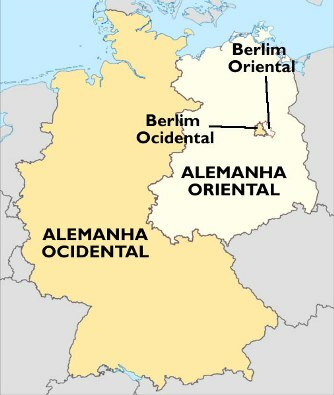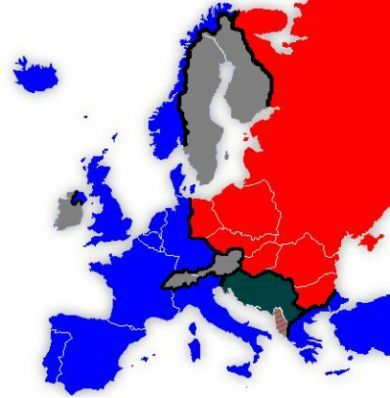At the end of the Second World War (1939-1945), the world political scene witnessed the period of greatest tension in its history. On the one hand, the United States (USA), a capitalist power; on the other, the Soviet Union (USSR), a socialist power; on both sides, weapons with nuclear technology that could cause serious harm to all humanity.
In the end, no shots were fired directly between the two sides of the "conflict", which justifies the name Cold War. What can be said is that this conflict was marked by indirect disputes between the two powers rivals in search of greater political and, especially, military power over different parts of the world.
This configuration occurred due to the fact that a nuclear war would not be beneficial to any of the blocks involved in it. The world would only know chaos and the possible winner of this conflict would have nothing to celebrate, as there would only be radiation and structural problems in the geographical space of the defeated country. For this reason, sociologist Raymond Aron uttered a phrase that has become known worldwide:
"The Cold War was a period when war was unlikely and peace impossible".Mind Map - Cold War

To download the mind map, Click here!
The Sharing of Germany
Nazi Germany was the great defeated of World War II and, with that, had its territory dominated and controlled by the countries that formed the allied base during the conflict: USA, USSR, France and England. These countries, at the Potsdam Conference in 1945, divided German space into two main parts: on the one hand, West Germany, dominated by capitalist nations; on the other, East Germany, dominated by the Soviet Union. The capital Berlin was also divided equally. Look at the map below:

Division of Germany after the end of World War II¹
Marshall Plan x Molotov Plan
It wasn't just Germany that was damaged by World War II. As this event took place almost entirely on European territory, most of the countries involved suffered severe economic, social and structural consequences. Due to this weakness, the United States triggered what was called Marshall Plan, in which large loans were given to these countries for their reconstructions.
This posture was an American strategy to prevent European nations, due to their relative weaknesses, suffered Soviet interventions, in addition to being an action to contain possible socialist movements and revolutions internal. With this, the United States consolidated its base of influence in what was called the “European West”, or Capitalist Europe, in opposition to Eastern Europe, which was formed by the territories of domain and influence Soviets. In addition to the Marshall Plan, the United States also created the Columbus Plan, which had the same function, except that its target was the Asian countries.
Among the countries that most received aid from the Americans, the United Kingdom leads the list, followed, respectively, by France, Japan, Italy, West Germany, among others.
In response to the Marshall Plan, the Soviet Union drew up the call Molotov Plan, with the same objective of providing ample economic aid to other territories in order to expand their influence space around the world. This financial aid involved virtually all countries with socialist influence, such as East Germany, Poland, Bulgaria, Cuba and many others.
Do not stop now... There's more after the advertising ;)
NATO vs. Warsaw Pact
In a scenario that increasingly favored the tension between the two power blocs during the Cold War, the organization of institutions and military pacts was essential on both sides.
With that, on the capitalist side, the North Atlantic Treaty Organization (NATO), which still exists and is one of the most powerful institutions today. On the socialist side, the Warsaw Pact. These organizations worked in the following way: if one of their member countries was attacked, the other parties must immediately intervene or send aid. This contributed to the emergence of several indirect combats that took place during this period, such as the Korean War (1950-1953) and the Vietnam War (1959-1975). .
With these actions and interventions by the two power blocs, there was a division of space world territory, which was more concentrated in the countries of Europe, which were the protagonists of the call Iron Curtain, which divided the socialist territories from the capitalists.

Illustration of the division of European space by the Iron Curtain²
The arms and space races
The dispute between the USA and the USSR did not only occur on the territorial, political and world economic level. The main element in dispute was military and technological hegemony. In this sense, the two countries were involved in a blind race to decide which of the two powers had the greatest amount of nuclear weapons and technologies, as well as the best programs and achievements space.
At the military level, the United States, since the end of World War II, dominated production and use of the atomic bomb, such as those that caused the destruction of the Japanese cities of Hiroshima and Nagasaki. Later, in 1949, the Soviet Union also announced its dominance over nuclear technology.
On the spatial plane, it was the Soviet Union that took off. In 1957, the first man-made space satellite, Sputnik, was launched by the Soviets. In the same year, Sputnik 2 entered orbit, which consisted of the first trip to space manned by a living being (in this case, the famous dog Laika). To complete the feats, the socialists were also the first to photograph the surface of the Moon (in 1959) and the first to send a human being into space, in 1961.
Thus, in the following year, 1962, the United States finally managed to respond to heights with the first spaceflight around the Earth. In 1969, the long-awaited visit to the Moon by the United States took place, in the mission operated by the Apollo 11 crew.
Despite some agreements signed, mainly in the military plan, the arms and space races, according to most of the analysts, only knew its end with the Soviet crisis and the end of the Cold War, at the end of the 1980s and beginning of the 1990.
______________________
¹Image Credits: W. B. Wilson
²Image credits: Kseferovic
By Rodolfo Alves Pena
Graduated in Geography
*Mental Map by Daniel Neves


